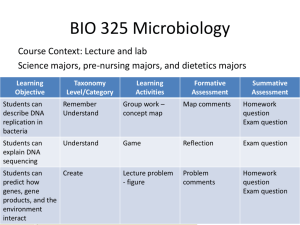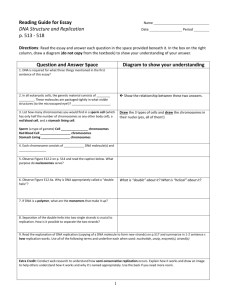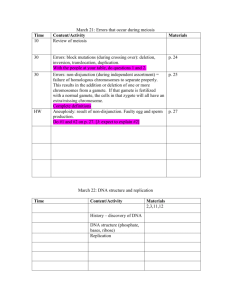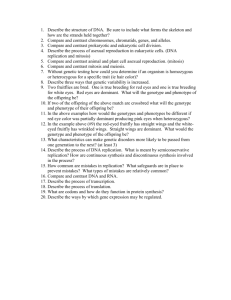Lecture 12 Slides
advertisement
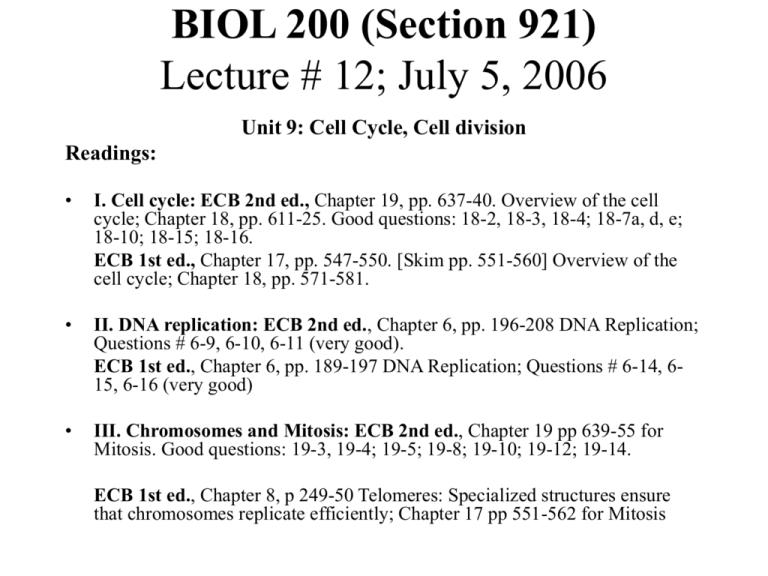
BIOL 200 (Section 921) Lecture # 12; July 5, 2006 Unit 9: Cell Cycle, Cell division Readings: • I. Cell cycle: ECB 2nd ed., Chapter 19, pp. 637-40. Overview of the cell cycle; Chapter 18, pp. 611-25. Good questions: 18-2, 18-3, 18-4; 18-7a, d, e; 18-10; 18-15; 18-16. ECB 1st ed., Chapter 17, pp. 547-550. [Skim pp. 551-560] Overview of the cell cycle; Chapter 18, pp. 571-581. • II. DNA replication: ECB 2nd ed., Chapter 6, pp. 196-208 DNA Replication; Questions # 6-9, 6-10, 6-11 (very good). ECB 1st ed., Chapter 6, pp. 189-197 DNA Replication; Questions # 6-14, 615, 6-16 (very good) • III. Chromosomes and Mitosis: ECB 2nd ed., Chapter 19 pp 639-55 for Mitosis. Good questions: 19-3, 19-4; 19-5; 19-8; 19-10; 19-12; 19-14. ECB 1st ed., Chapter 8, p 249-50 Telomeres: Specialized structures ensure that chromosomes replicate efficiently; Chapter 17 pp 551-562 for Mitosis Learning objectives I. Introduction and Overview of Cell Cycle; Regulation of cell cycle by CDK-cyclin • Understand overall organization of the cell cycle and its relation to cell division (mitosis and cytokinesis): • Be able to list cell cycle stages in order and indicate the location of the two major cell cycle control points. • Give examples of discrete and continuous cell cycle processes. • Understand the checkpoint concept and how this allows Integration of continuous and discrete cell cycle processes • Understand the role of CDK-cyclin in regulation of cell cycle processes. • Be able to explain how the CDK complex is regulated by protein phosphorylation, and by proteolysis. II. DNA Replication • Explain what is meant by semi-conservative replication of DNA. • Explain how DNA replication occurs in eukaryotes through the independent operation of many replicons. • Describe the roles of the following in DNA replication: Helicase, DNA polymerase, primer, Okazaki fragments, ligase. • Explain the terms lagging and leading strand and the significance of these terms for DNA replication. • Understand the relation between chromatids and chromosomes in both pre- and post-replication stages • Explain and understand replicon and replication fork. III. Chromosomes and Mitosis • Understand why telomeres are important and how telomere extension occurs • List the stages of mitosis in order and explain what is happening to the cytoskeleton, the mitotic spindle, the nuclear envelope and the chromosomes during this process. • Explain how chromosomes are moved to the poles at mitosis. • What are kinetochores and what are they good for. Cell cycle • Cells arise from pre-existing cells • The reproduction of cells takes place in an orderly fashion and is genetically regulated • Cells reproduce by a process called the cell cycle which show (i) cell growth and chromosome replication, (ii) chromosome segregation and (iii) cell division • Each cell type has its own timing and built-in memory • For example, cell cycle time varies from about 0.5 hours in early frog embryo cells to about 1 year in human liver cells Four phases of the cell cycle [Fig. 18-2] • M phase includes nuclear division and cytokinesis • G1 – the interval between M and S phases • S phase – replication • G2 – the interval between S phase and mitosis A central control system (like a washing machine) triggers the major processes of the cell cycle [Fig. 18-3] • Like a clotheswashing machine, there is a feedback at each stage • The next stage can not begin until the previous one has ended • This is a system of checkpoints Two major checkpoints in the cell cycle • There is a checkpoint in G1 for cell size. If the cell has not grown sufficiently, it will be held in G1 until that happens • Similarly, there is a checkpoint in G2 that ensures replication is complete before mitosis begins • Checkpoints also take into account signals from other cells and environment. ‘COMMITMENT TO DIVN.’ ‘START’ Xenopus egg, does not divide unless activated [Fig. 18-8] microinjection of cytoplasm extract into egg activates mitosis [Fig. 18-9] Inject cytoplasm from m phase cell Promotes mitosis Inject cytoplasm From interphase cell No mitosis, stays in interphase CONCLUSION: Some kind of cytoplasmic factor promotes cell division – called m phase promoting factor (MPF) Cyclin-CDK complex [Fig. 18-5] Cyclin-dependent kinase (Cdk) Cyclinamount varies during cell cycle The major Cyclins and Cdks [Table 18-2] -------------------------------------------------------Cyclin-Cdk Cyclin Cdk partner Complex --------------------------------------G1-Cdk cyclin D Cdk4, Cdk6 G1/S-Cdk cyclin E Cdk2 S-Cdk cyclin A Cdk2 M-Cdk cyclin B Cdk1 -------------------------------------------------------- Changes in [M-cyclin] and M-Cdk activity during the cell cycle [Fig. 18-6] Factors affecting the activity of Cdks 1. 2. 3. 4. Cyclin degradation by ubiquitination Phosphorylation and dephosphorylation Positive feedback Cdk inhibitor proteins Cyclin degradation by ubiquitination inhibits the activity of Cdks [Fig. 18-7] 18_07_cyclin_degradat.jpg Phosphorylation and Dephosphorylation • Cell cycle control is regulated by phosphorylation and dephosphorylation • Protein kinases and phosphatases form a switch • Protein kinases that control cell cycle are present throughout the cell cycle. Their activity rises and falls. • A second set of proteins CYCLINS have no enzyme activity themselves. They bind to kinases and activate them. • The kinases of the cell cycle control system are known as cyclin-depedent protein kinases or Cdks. Protein phosphorylation [Fig. 4-41] kinase adds Phosphatase removes phosphate group Protein phosphorylation acts as a switch to modify protein activity [Fig. 4-41] Selective phosphorylation and dephosphorylation activate M-Cdk [Fig. 18-11] 18_11_M_Cdk_active.jpg Thr 14, Tyr 15 Thr 161 Fig. 18-12: CDK phosphorylates activating phosphatase: further activation of CDK via a positive feedback loop. Different cyclin-Cdk complexes trigger different events in cell cycle [Fig. 18-13] 18_13_Cdks_cyclins.jpg M-Cdk effects 1. M-Cdk contains a single protein kinase, which triggers mitosis 2. It phosphorylates MAPs and causes cytoskeleton to reorganize – forming the spindle 3. It posphorylates the nuclear lamina and causes the nuclear envelope to break down. 4. It phosphorylates non-histone proteins and causes chromosome condensation DNA damage arrests the Cell cycle in G1 [Fig. 18-15] 18_15_cell_cycle_G1.jpg The cell-cycle control system can arrest the cycle at various checkpoints [Fig. 18-17] 18_17_arrest_checkpt.jpg Cell below critical size Cell below critical size DNA replication Learning objectives • Explain what is meant by semi-conservative replication of DNA. • Explain how DNA replication occurs in eukaryotes through the independent operation of many replicons. • Describe the roles of the following in DNA replication: Helicase, DNA polymerase, primer, Okazaki fragments, ligase. • Explain the terms lagging and leading strand and the significance of these terms for DNA replication. • Understand the relation between chromatids and chromosomes in both pre- and post-replication stages • Explain and understand replicon and replication fork Semiconservative replication of DNA: Each daughter strand has one DNA template from parental strand [Fig. 6-3] “S” PHASE Replication initiator proteins open up a DNA double helix at its replication origin [Fig. 6-5] 06_05_replic.origin.jpg 06_09_Replic.forks.jpg Replication fork moves away in both directions 06_10_5prime_3prime.jpg DNA synthesis in the 5’→3” direction The two newly synthesized DNA strands have opposite polarity 06_11_oppositepolarity.jpg DNA replication forks are asymmetrical [Fig. 6-12] 06_12_asymmetrical.jpg DNA POLYMERASE CATALYZE BOTH DNA REPLICATION AND EDITING (PROOFREADING) [Fig. 6-14] 06_14_polymerase2.jpg On the lagging strand, DNA is synthesized in fragments [Fig. 6-16] 06_16_lagging strand.jpg 06_17_group proteins.jpg A group of proteins act together at a replication fork A protein machine in DNA replication Key Players • • • • • Leading strand DNA Lagging strand DNA DNA Polymerase III Helicase RNA Primase and RNA Primers • Okazaki Fragments • Ligase • Single-stranded DNA binding proteins Becker et al. The World of the Cell] Chromosomes and Mitosis: Learning objectives • Understand why telomeres are important and how telomere extension occurs • List the stages of mitosis in order and explain what is happening to the cytoskeleton, the mitotic spindle, the nuclear envelope and the chromosomes during this process. • Explain how chromosomes are moved to the poles at mitosis. • What are kinetochores and what are they good for. 3 DNA sequences needed to produce a eukaryotic chromosome [Fig. 5-18] 1. telomere 2. origin of replication 3. centromere Telomeres allow the completion of DNA synthesis at the ends of Chromosomes [Fig. 6-18] 06_18_telomeres.jpg Telomerase contains a Short piece of RNA which acts as a primer for DNA synthesis The cytoskeleton is involved in both mitosis and cytokinesis 19_04_mediate_M.jpg Mitosis separates sister chromatids into daughter chromosomes [Fig. 19-6] Panel 19-1: prophase Mitotic chromosome [Fig. 19-3] 2 chromatids centromere What keeps the 2 chromatids together? Cohesins hold sister chromatids together. Condensins help pack chromatin into chromosomes [Fig. 19-3] Where would you expect to find cohesins in this centrosome Fig. 19-5: centrosomes duplicate to form mitotic spindle poles. duplication Mitotic spindle poles Fig. 19-7: Mitotic spindle Selective stabilization of interpolar MT prophase Panel 19-1: prometaphase Dynamic instabilityMT’s shoot out of spindle poles. Fig. 17-9: Kinetochore is protein complex at centromere region of chromosome MT bind here Panel 19-1: Metaphase Fig. 19-13: Mitotic spindle at metaphase Kinetochore microtubules Interpolar microtubules Panel 19-1: Anaphase Fig. 19-17: Anaphase A-sister chromosomes separate by kinetochore MT shortening Fig. 19-17: Anaphase B-poles move apart by polar MTs sliding past each other motors slide polar MTs The anaphase promoting factor (APC) triggers the separation of sister chromatids by promoting the destruction of cohesins [Fig. 19-16] 19_16_APC_triggers.jpg Fig. 19-19: cleavage furrow made by actinmyosin ring pulling PM in to divide daughter cells Cytokinesis-division of cytoplasm due to actin-myosin contractile ring 19_20_contractile_ring.jpg Fig. 18-38: Golgi derived vesicles make a new cell wall in plants mitotic spindle Golgi Cell plate Decondensing chromosomes of daughter nuclei Fig. 19-22: cell plate forms during cytokinesis in plants
